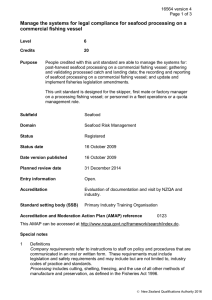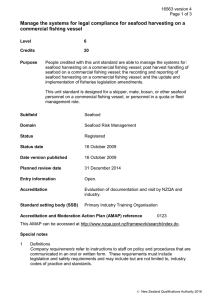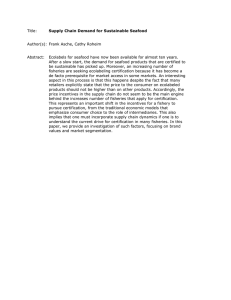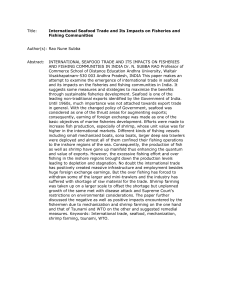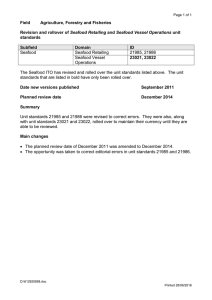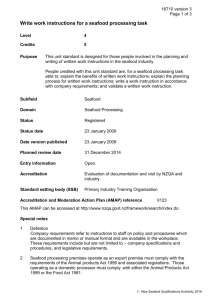Describe legislative compliance for seafood harvesting on a commercial fishing vessel
advertisement
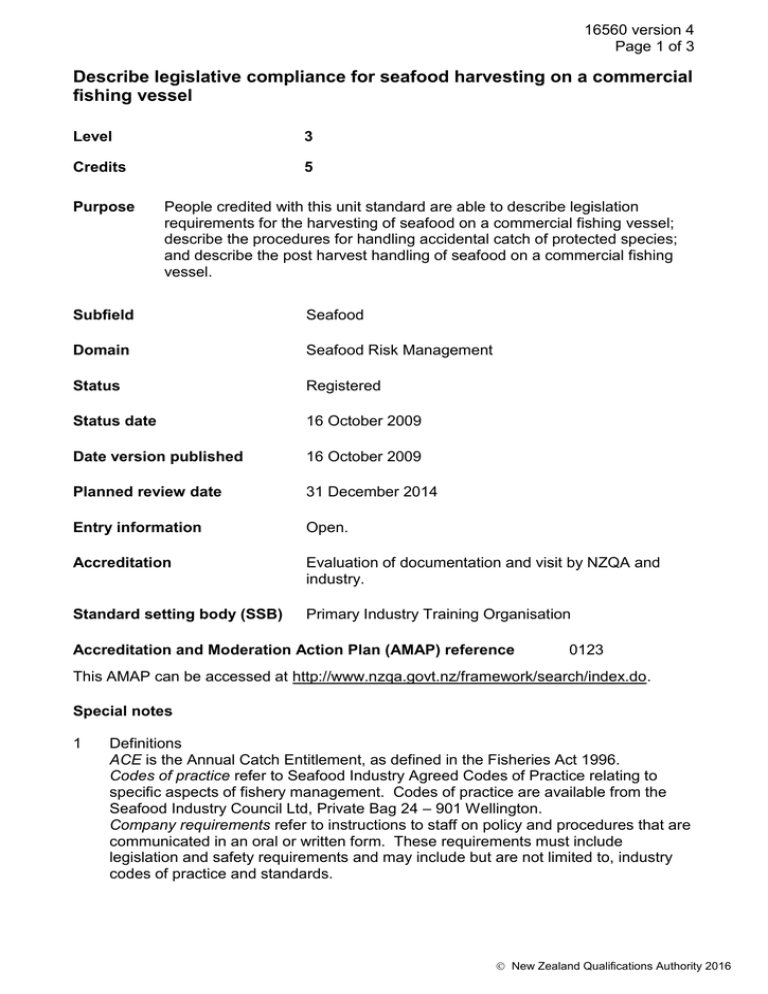
16560 version 4 Page 1 of 3 Describe legislative compliance for seafood harvesting on a commercial fishing vessel Level 3 Credits 5 Purpose People credited with this unit standard are able to describe legislation requirements for the harvesting of seafood on a commercial fishing vessel; describe the procedures for handling accidental catch of protected species; and describe the post harvest handling of seafood on a commercial fishing vessel. Subfield Seafood Domain Seafood Risk Management Status Registered Status date 16 October 2009 Date version published 16 October 2009 Planned review date 31 December 2014 Entry information Open. Accreditation Evaluation of documentation and visit by NZQA and industry. Standard setting body (SSB) Primary Industry Training Organisation Accreditation and Moderation Action Plan (AMAP) reference 0123 This AMAP can be accessed at http://www.nzqa.govt.nz/framework/search/index.do. Special notes 1 Definitions ACE is the Annual Catch Entitlement, as defined in the Fisheries Act 1996. Codes of practice refer to Seafood Industry Agreed Codes of Practice relating to specific aspects of fishery management. Codes of practice are available from the Seafood Industry Council Ltd, Private Bag 24 – 901 Wellington. Company requirements refer to instructions to staff on policy and procedures that are communicated in an oral or written form. These requirements must include legislation and safety requirements and may include but are not limited to, industry codes of practice and standards. New Zealand Qualifications Authority 2016 16560 version 4 Page 2 of 3 2 Fisheries legislation requirements include but are not limited to the Fisheries Act 1996 and associated regulations; New Zealand Bill of Rights Act 1990; and their subsequent amendments. Elements and performance criteria Element 1 Describe legislation requirements for the harvesting of seafood on a commercial fishing vessel. Performance criteria 1.1 The description includes the targeted species and harvest area in accordance with the vessel fishing permit and/or plan. Range permit and/or plan includes but is not limited to – permit holder access to ACE, ACE by area, and non-quota species. 1.2 The description includes the vessel, fishing method, fishing permit and fishing gear required for the targeted species in accordance with fisheries legislation requirements. 1.3 The description includes the supporting documentation and information required for the effort data in accordance with fisheries legislation requirements and company requirements. Range includes but is not limited to – estimated catch of each species, fishing gear data, position. Element 2 Describe the procedures for handling accidental catch of protected species. Performance criteria 2.1 The description includes the harvesting techniques used to minimise accidental catch of protected species in accordance with fisheries legislation requirements and industry codes of practice. 2.2 The description includes the procedures for releasing accidental catch of protected species in accordance with fisheries legislation requirements and industry codes of practice. 2.3 The description includes the procedures for recording accidental catch of protected species in accordance with fisheries legislation requirements and industry codes of practice. New Zealand Qualifications Authority 2016 16560 version 4 Page 3 of 3 Element 3 Describe the post harvest handling of seafood on a commercial fishing vessel. Performance criteria 3.1 The description includes the systems used to ensure that decisions on the post harvest handling of the seafood are made in accordance with fisheries legislation requirements. 3.2 The description includes the preparation of catch data in accordance with fisheries legislation requirements, reporting regulations and vessel procedures. Range includes but is not limited to – fish identification, estimated weight landed, discards, eaten, accidentally lost, minimum legal size. Please note Providers must be accredited by NZQA, or an inter-institutional body with delegated authority for quality assurance, before they can report credits from assessment against unit standards or deliver courses of study leading to that assessment. Industry Training Organisations must be accredited by NZQA before they can register credits from assessment against unit standards. Accredited providers and Industry Training Organisations assessing against unit standards must engage with the moderation system that applies to those standards. Accreditation requirements and an outline of the moderation system that applies to this standard are outlined in the Accreditation and Moderation Action Plan (AMAP). The AMAP also includes useful information about special requirements for organisations wishing to develop education and training programmes, such as minimum qualifications for tutors and assessors, and special resource requirements. Comments on this unit standard Please contact the Primary Industry Training Organisation standards@primaryito.ac.nz if you wish to suggest changes to the content of this unit standard. New Zealand Qualifications Authority 2016
